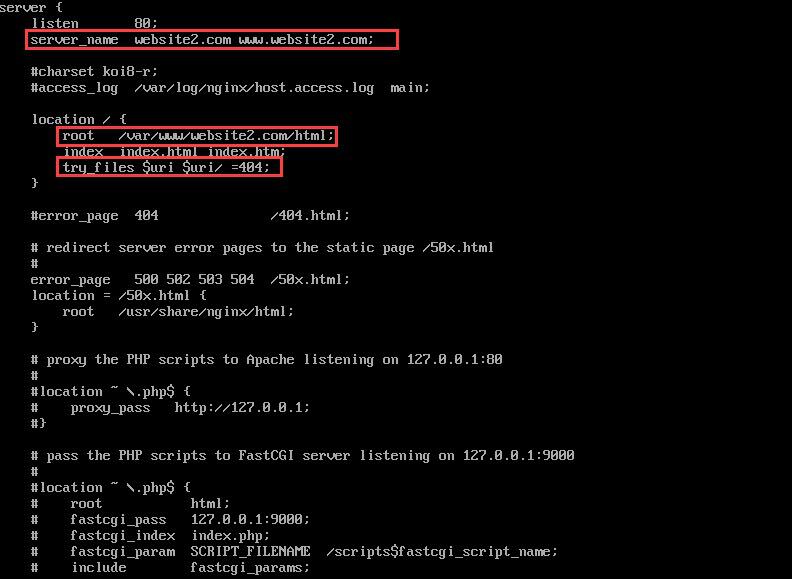This article covers a version of CentOS that is no longer supported. If you are currently operating a server running CentOS 6, we highly recommend upgrading or migrating to a supported version of CentOS.
Reason:CentOS 6 reached end of life (EOL) on November 30th, 2020 and no longer receives security patches or updates. For this reason, this guide is no longer maintained.
See Instead:This guide might still be useful as a reference, but may not work on other CentOS releases. If available, we strongly recommend using a guide written for the version of CentOS you are using.
The following DigitalOcean tutorial may be of interset, as it outlines setting up Nginx Server Blocks on a CentOS 7 server:
Virtual Hosts are used to run more than one website or domain off of a single virtual private server.Note: according to the nginx website, Virtual Hosts are called Server Blocks on nginx. However, for the sake of easy comparison with Apache, I'll refer to them as virtual hosts throughout this tutorial.
Make sure that nginx is installed on your VPS. If it is not, you can quickly install it with 2 steps.
Install the EPEL repository:
su -c 'rpm -Uvh http://dl.fedoraproject.org/pub/epel/6/x86_64/epel-release-6-8.noarch.rpm'Install nginx
yum install nginxThe first step in creating a virtual host is to a create a directory where we will keep the new website’s information.
This location will be your Document Root in the Nginx virtual configuration file later on. By adding a -p to the line of code, the command automatically generates all the parents for the new directory.
sudo mkdir -p /var/www/example.com/public_htmlYou will need to designate an actual DNS approved domain, or an IP address, to test that a virtual host is working. In this tutorial we will use example.com as a placeholder for a correct domain name.
However, should you want to use an unapproved domain name to test the process you will find information on how to make it work on your local computer in Step Six.

We need to grant ownership of the directory to the right user, instead of just keeping it on the root system. You can replace the "www" below with the appropriate username.
sudo chown -R www:www /var/www/example.com/public_htmlAdditionally, it is important to make sure that everyone is able to read our new files.
sudo chmod 755 /var/wwwNow you are all done with permissions.
We need to create a new file called index.html within the directory we made earlier.
sudo vi /var/www/example.com/public_html/index.htmlWe can add some text to the file so we will have something to look at when the the site redirects to the virtual host.
<html><head><title>www.example.com</title></head><body><h1>Success: You Have Set Up a Virtual Host</h1></body></html>Save and Exit
The next step is to enter into the nginx configuration file itself.
sudo vi /etc/nginx/conf.d/virtual.confThe virtual host file is already almost completely set up on your virtual server. To finish up, simply match the following configuration, modifying the server name and file location as needed:
## A virtual host using mix of IP-, name-, and port-based configuration#server {listen 80;#listen *:80;server_nameexample.com;location / {root /var/www/example.com/public_html/; indexindex.html index.htm;}}Save and exit.
We’ve made a lot of the changes to the configuration. Restart nginx and make the changes visible.
/etc/init.d/nginx restartIf you have been using an actual domain or IP address to test your virtual servers, you do not need to set up local hosts. However, if you are using a generic domain that you do not own, this will guarantee that, on your computer only, you will be able to customize it.
For this step, make sure you are on the computer itself, not your VPS.
To proceed with this step you need to know your computer’s administrative password, otherwise you will be required to use an actual domain name or your IP address to test the virtual hosts.
Assuming that you do have admin access (gained by typing su and entering the correct password) here is how you can set up the local hosts.
On your local computer, type:
nano /etc/hostsYou can add the local hosts' details to this file, as seen in the example below. As long as line with the IP address and server name is there, directing your browser toward, say, example.com will give you all the virtual host details for the corresponding IP address that you designated.
# Host Database## localhost is used to configure the loopback interface# when the system is booting.Do not change this entry.##127.0.0.1 localhost#Virtual Hosts 12.34.56.789www.example.comHowever, it may be a good idea to delete these made up addresses out of the local hosts folder when you are done to avoid any future confusion.
Once you have finished setting up your virtual host, you can see how it looks online. Point your browser to your domain name or IP address, and you should see that the page displays, "Success—You Have Set Up a Virtual Host"
To create additional virtual hosts, you can just repeat the process above, being careful to set up a new document root with the appropriate new domain name each time. Then just copy and paste the new Virtual Host information into the nginx Config file, as shown below
## A virtual host using mix of IP-, name-, and port-based configuration#server {listen 80;#listen *:80;server_nameexample.com;location / {root /var/www/example.com/public_html/; indexindex.html index.htm;}}server {listen 80;#listen *:80;server_nameexample.org;location / {root /var/www/example.org/public_html/; indexindex.html index.htm;}}By Etel Sverdlov
PREV: Event ID: 3003 (A validation error has occurred) [Client Side ...